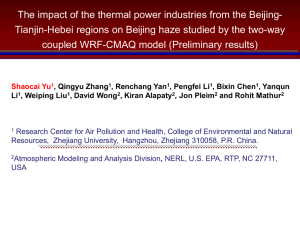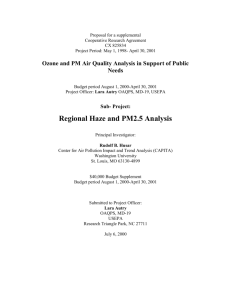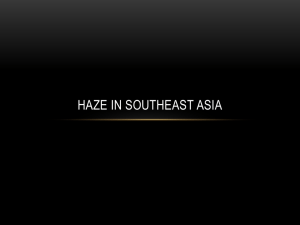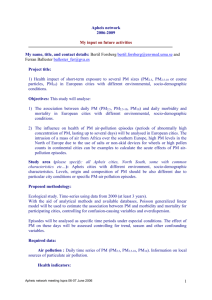Visualization of Transboundary Air Pollutant Transport to
advertisement
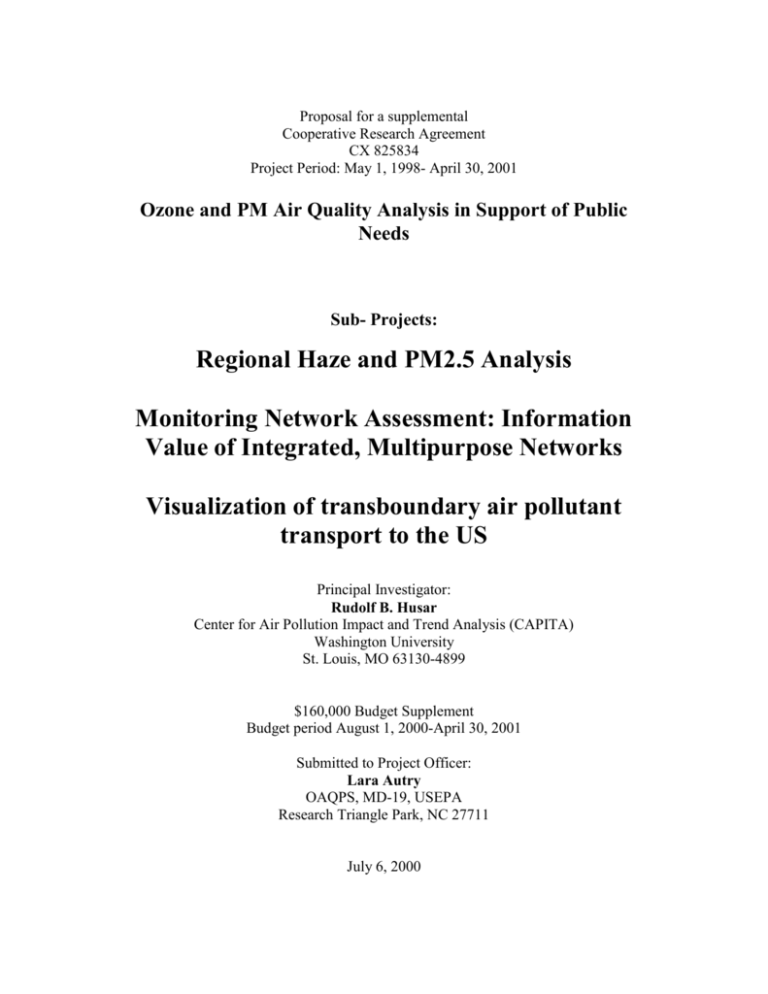
Proposal for a supplemental Cooperative Research Agreement CX 825834 Project Period: May 1, 1998- April 30, 2001 Ozone and PM Air Quality Analysis in Support of Public Needs Sub- Projects: Regional Haze and PM2.5 Analysis Monitoring Network Assessment: Information Value of Integrated, Multipurpose Networks Visualization of transboundary air pollutant transport to the US Principal Investigator: Rudolf B. Husar Center for Air Pollution Impact and Trend Analysis (CAPITA) Washington University St. Louis, MO 63130-4899 $160,000 Budget Supplement Budget period August 1, 2000-April 30, 2001 Submitted to Project Officer: Lara Autry OAQPS, MD-19, USEPA Research Triangle Park, NC 27711 July 6, 2000 Regional Haze and PM2.5 Analysis Background This is a brief proposal to EPA OAQPS as part of the Cooperative Agreement CX 825834 "Ozone and PM Air Quality Analysis in Support of Public Needs" between EPA and CAPITA. The new haze regulations will require the states to estimate the level of haze based upon the chemical composition of the dry ambient aerosol. The states as well as the general public needs to better understand the causal mechanism for haze as well as the relationship between the measured PM2.5concentrations and the haze regulations. The purpose of the proposed analysis is to provide background information on haze including the PM2.5-haze relationship. The information will be presented in such a way that it can aid all the main stakeholders involved including federal, state and local agencies as well as the interested public. In addition, the first year of the FRM PM2.5 data, collected by the National fine particle monitoring network, is due to be delivered by the States to AIRS by March 31, 2000. CAPITA will cooperate with OAQPS in obtaining and exploring these data, followed by initial analysis of these data. The specific goals of the this sub-project has three parts: 1) Write a chapter on haze for the PM Analysis Workbook. 2) Explore the first year of FRM PM2.5 data examining the content of the database, its quality and generating overall statistics. Haze Chapter for the PM Analysis Workbook The new haze regulations require states to establish baseline haze levels and the natural conditions, i.e. haze levels that would exist without anthropogenic contributions, for all Class I areas. In addition, all states will need to access their contributions to haze in Class I areas and provide State Implementation Plans to remove their contributions to the anthropogenic haze in the Class I areas. The PMfine workbook haze chapter will contain three sections to aid states in complying with the new haze rules. 1) Background information on the physical mechanism responsible for haze. Many states are unfamiliar with the causal factor of haze. Therefore, a section that provides background information on haze from the nature of light to its interaction with ambient particles will be provided. There are a number of excellent sources of information on the causes of haze such as the 1978 Visibility Report to Congress, the NAPAP report Volume 24 and the more recent publication "Introduction to Visibility" by William Malm that will be drawn upon for this section. 2) Relationship between haze and PM2.5. The new haze regulations require haze levels to be estimated from measured aerosol samples. This section of the 2 workbook will describe the relationship between haze and PM2.5, as well as established technique for reconstructing haze from the measured aerosol samples. 3) Fine mass and haze patterns and trends. National and seasonal patterns of the PM2.5 mass, its constituents and the haze levels reconstructed from the aerosol data will be presented. In addition National haze maps derived from visibility airport concentrations and their long-term trends, i.e. from 1940-95, will be presented. Last, estimates of the natural background levels as report in the NAPAP report will be provided. Exploration of FRM PM2.5 Data - Year 1 The national PM2.5 network has been in operation since January 1999 and the first year of data will be available from AIRS for analysis in early April. CAPITA will cooperate with OAQPS in the initial analysis of these data in four ways: 1) Enhancing the data availability. The FRM PM2.5 data will be available from the EPA AIRS database. Experience has shown that there are a number of resistances to accessing AIRS data which are difficult for most people to overcome. Therefore, CAPITA will obtain all FRM PM2.5 data from AIRS, and reformat it into ASCII and Voyager files. These resulting data files will be made available via the PMfine workbook website. 2) FRM PM2.5 monitoring sites and data collection statistics. The overall distribution of the data will be documented. This will include maps of the location of the monitoring sites, the monitoring sites starting dates and the monitoring sites collection statistics. 3) Quality assurance and control of the database. Initial quality assurance and control will be conducted by examining the data for each site for spatial and temporal consistency. This cursory examination will be designed to identify outlying data points. 4) PM2.5 data analysis. Simple statistical analyses examining overall spatial and temporal patterns of the data will be conducted. These analyses will include examination of PM2.5 seasonal maps as well regional statistics including, mean, standard deviation, and the upper and lower percentiles. The initial exploration of the database will be completed by the end of May, in time for EPA's initial FRM PM2.5 data report. More detailed data analysis of the data will continue after May. The exact analyses to be conducted will be guided by the results of the initial analysis and feedback from interaction with the data users. Schedule The work will be conducted during August, 2000 – April, 2001. Intermediate outputs will be discussed with the Project Officer, Lara Autry. 3 Budget The budget for the project is $40,000. The detailed budget is listed in the attachment. The project will be conducted through incremental funding to the Cooperative Agreement CX 825834 between EPA and CAPITA “Ozone and PM Air Quality Analysis in Support of Public Needs”. Personnel The project will be conducted by Professor Rudolf B. Husar, director of the Center for Air Pollution Impact and Trend Analysis. One or two graduate students will participate in the project. Drs. Stefan Falke and Bret Schichtel will serve as consultants to the project. 4 Monitoring Network Assessment: Information Value of Integrated, Multipurpose Networks Background Recently, EPA/OAQPS has initiated a new program to make the existing air quality networks more responsive to the needs of air quality management. This may involve adding and removing stations, and samplers as well as modifying their operating procedures. New samplers are added to the network when a pollutant needs to be characterized in more detail, e.g. characterization of ozone precursors through PAMS. New samplers are also added to the network when a new standard is established as in the case of PM2.5. In general, all these activities tend to increase the number of monitoring sites and the associated national expense for maintaining the increasing air quality monitoring networks. Removal of monitoring stations or samplers has been avoided by applying the rationale that: a) The more data are being collected the better off we are. b) It is good to have a long-term record from the same site. c) It is not clear how to evaluate the relative importance of different monitoring sites and samplers, so might as well keep the stations operating. Given the limited financial resources available for monitoring the above-described network growth is not sustainable and results in sub-optimal resource utilization. Network optimization requires stating the network purposes such as monitoring for compliance with NAAQS or documenting trends. The network purpose leads to the specification of the network evaluation criteria. Network optimization may apply subjective and objective evaluation criteria. Subjective criteria are those that arise during discussion of the network management process and involve from the subjective judgements of the participants. Objective methods of network evaluation can be formulated algorithmically and can be used to support the network management decisions. The development of the network optimization algorithms is hampered by several difficulties including: 1. The network optimization paradox: in order to evaluate the network's ability to characterize the 'reality', the reality needs to be known. If the reality is fully known, there is no particular need to monitor. 2. Network integration problem: air quality monitoring networks are generally not monolithic but they are composed of sub-networks with subtle and sometimes significant differences in samplers and sampling protocols. Network optimization requires the integration and fusion of sub-networks (e.g. PM2.5, FRM, IMPROVE, CASTNET, possibly Supersites) 3. Multipurpose utilization of networks: the air quality data from a given sampler can be used for multiple purposes where each purpose, may demand different evaluation criteria. For example, the evaluation based on NAAQS compliance needs to adhere to the criteria set by the regulatory standard. On the other hand, the use of the data for source attribution may apply multiple criteria using many different source-attribution methods. Purpose of the Project The purpose of the project is to develop a set of objective, network evaluation algorithms, and to apply those algorithms to assess the network performance for the criteria pollutants (O3, PM2.5, CO, SO2 NOX), with special emphasis on O3 and PM2.5. Specific Objectives of this Work The specific objectives set forth for this project are three fold: 1. Develop objective criteria and algorithms by which the network performance can be evaluated. 2. Integrate the existing network data into a homogeneous datasets with special emphasis on O3 and PM2.5. 2. Apply the developed algorithms to the best available integrated data sets to evaluate the network performance from multiple perspectives. Approach The approach to the project follows closely the list of specific objectives stated above. Objective criteria and algorithms for network performance evaluation A key concept for developing a network evaluation criteria is the information value contributed by each station. The information value, I, is composed of two parts: E and W. The parameter E represents the error reduction (uncertainty reduction) that a given station contributes. The value of E is large for those stations whose data are substantially different than estimates derived by other means, e.g. extrapolation from neighboring stations. The value of E is small if the concentration values estimated by other means are the same as the measured value. In this latter case, the station does not add information, i.e. does not reduce the uncertainty of concentration estimates. The magnitude of W represents a weighing factor that weights the importance of a given measurement from the point of view of pollutant impacts. For example, in case of population exposure, the value of W may be taken in proportion to the number of people in the region of influence of a given station. The overall value of the information provided by a given station is then composed of (1) how much it reduces the overall concentration uncertainty and (2) how much weight is given to the station due to the receptor impacts. The above-illustrated algorithm represents one possible way of evaluating a network performance. This method has been explored in a brief preliminary study that is available "Information Value of Air Quality Network Stations: Illustration for Ozone 6 Monitoring over the Eastern US" http://capita.wustl.edu/CAPITA/capitareports/NetInfoValue/NetInfoValue.htm The above example illustrates the network evaluation based on spatial coverage. It is clear that evaluation for detecting trends will require a development of additional criteria. Integration of network data with special emphasis on O3 and PM2.5. In order to evaluate the performance of the existing networks for the criteria pollutants the most recently available data need to be accessed including the NAMS/SLAMS, IMPROVE, and CASTNET networks. In the past CAPITA has integrated these data sets. The available ozone data sets from NAMS/SLAMS and CASNET were integrated in order to provide science support to the OTAG process. The report that describes the ozone data integration effort can be found at the website below: "Ozone Data Integration for OTAG Air Quality Analysis and Model Evaluation" http://capita.wustl.edu/CAPITA/Awma98/HTTP/98_A929.htm The available PM2.5 data sets were also integrated during Year 1 of this cooperative agreement (CX 825834). The report describing the integrated fine particle data sets can be found on the website: "North American Integrated Fine Particle Data" http://capita.wustl.edu/datawarehouse/Datasets/CAPITA/NAMPM_25/Data/NAMPM25.html "North American Integrated Fine Particle Data Set" http://capita.wustl.edu/CAPITA/CapitaReports/Awma99/NamPM/NAMPMdata.htm The integrated data sets will need to be updated. This is particularly important for the PM2.5 data since the PM2.5 network has been expanding rapidly since the introduction of the PM2.5 standard in 1998. Application of network performance evaluation algorithms to the best available integrated data sets In this task we will apply the developed network evaluation algorithms to the integrated data sets, with particular emphasis on ozone and PM2.5. An example of algorithm testing is given in the report "Information Value of Air Quality Network Stations: Illustration for Ozone Monitoring over the Eastern US" http://capita.wustl.edu/CAPITA/capitareports/NetInfoValue/NetInfoValue.htm The network evaluation will be conducted for the entire conterminous US territory. In developing and applying the algorithms we will seek close interaction with analysts within OAQPS as well as with interested participants from the states. Output of the Work The output of this activity will roughly coincide with the three tasks outlined in the Approach Section: 1. New algorithms for evaluating integrated networks using multiple evaluation criteria. 7 2. Integrated data sets, updated through at least 1999 containing data on criteria pollutants from NAMS/SLAMS, CASTNET, and IMPROVE networks. 3. Network performance evaluations will be provided that illustrate the information value contributed by individual stations. The evaluations will be made for multiple pollutants and evaluation criteria will include compliance with NAAQS, determination of trends, delivery of the information to the public and source identification. The entire network evaluation plan as well as appropriate intermediate results will be posted on the CAPITA website for purposes of interaction with interested collaborating analysts and managers. Schedule The work will be conducted during August, 2000 – April, 2001. Intermediate outputs will be discussed with the Project Officers, Laurel Schultz and Richard Scheffe. Budget The budget for the project is $90,000. The detailed budget is listed in the attachment. The project will be conducted through incremental funding to the Cooperative Agreement CX 825834 between EPA and CAPITA “Ozone and PM Air Quality Analysis in Support of Public Needs” Personnel The project will be conducted by Professor Rudolf B. Husar, director of the Center for Air Pollution Impact and Trend Analysis. One or two graduate students will participate in the project. Drs. Stefan Falke and Bret Schichtel will serve as consultants to the project. 8 Visualization of Transboundary Air Pollutant Transport to the US Background. Anthropogenic and natural pollutants generated in one country are regularly transported to other countries adding to their air quality burden. This is particularly true for Persistent Organic Pollutants (POP) that reside in the atmosphere for days or weeks. The transboundary transport affects the seasonal and yearly average concentrations in the US by elevating the ‘background’ levels. Local emissions are then superimposed on this elevated background, leaving less margin for homegrown contributions. Transboundary transport is also episodic, i.e. highly non-uniform in time. This is a continuation of work conducted under the project: "Investigation of Regional and Global Transport and Deposition of Persistent Organic Pollutants", a collaborative research projected between the North Carolina Supercomputing Center (NCSC) and the Center for Air Pollution Impact and Trend Analysis (CAPITA). The results of the CAPITA contribution to that project are available at the webpage: (http://capita.wustl.edu/CAPITA/CapitaReports/POPs/AMH_anal/NAM_AMH_Spr99.ht m) Goal of the Project Overall goal of the work is to create visualizations of transboundary airmass transport to the United States. The visualizations need to be suitable for presentation to national and international policy analysts. Specific Objectives of this Work The previous analysis examined the probable airmass pathways to 9 receptor sites during the spring of 1999. This proposed projected will expand on the previous work in three ways: 1. Airmass history residence time analysis will be conducted for 12 receptor sites including two sites in Alaska. 2. Airmass transport probabilities for the West Coast will be aggregated 3. Airmass transport pathways will be derived for all four seasons of 1999 as well as the yearly average. Approach Residence time analysis will be used to estimate the probable airmass transport pathways to the US border for each season as well as for the entire year of 1999. The residence time analysis uses back trajectories to estimate the fraction of time airmasses reside over a given region prior to impacting the receptor. By placing a uniform grid over a region and calculating the fraction of residence time for each cell residence time probability maps can be constructed. The most probable airmass pathways are then the regions with the highest airmass residence probability. This analysis will use an airmass history database consisting of ten day airmass histories for receptor sites space ~ 100 km apart along the boundaries of the conterminous US and Alaska. The airmass histories will be calculated every 6 hours over the year 1999 using the CAPITA Monte Carlo Model driven by the FNL global meteorological data. The FNL data will be obtained from the Air Resource Laboratories READY website and be reprocessed for suitable input into the Monte Carlo Model. Residence time probability fields will be calculated for each receptor site in the database for a winter, spring, summer and fall seasons of 1999, where the winter season is comprised of the months December, January, and February. The residence time analysis for West Coast, will be conducted by integrating the residence time analyses for each receptor along the West Coast. Fig. 1. Location of US receptor sites Output of the Work The main product of this work will be seasonal and yearly maps of airmass transport probabilities to each of the receptor site as well as to the West Coast. The general map layout is illustrated below. 10 We will also explore additional displays including animations and 3D rendering of transport. Schedule The work will be conducted during August, 2000 – April, 2001. Intermediate visualization outputs will be discussed with the Project Officer, Angela L. Bandemehr. Budget The budget for the project is $30,000. The detailed budget is listed in the attachment. The project will be conducted through incremental funding to the Cooperative Agreement CX 825834 between EPA and CAPITA “Ozone and PM Air Quality Analysis in Support of Public Needs” Personnel The project will be conducted by Professor Rudolf B. Husar, director of the Center for Air Pollution Impact and Trend Analysis. He will be assisted by one or two graduate students. Dr. Bret Schichtel will serve as a consultant to the project regarding the trajectory computations. 11 PROJECT TITLE: OZONE AND PM AIR QUALITY ANALYSIS IN SUPPORT OF PUBLIC NEEDS PROJECT PERIOD: 05/01/1998 - 04/30/2001 EPA ASSISTANCE ID NO. CX 825834-01-2 PRINCIPAL INVESTIGATOR: RUDOLF HUSAR SUPPLEMENTAL FUNDING REQUEST Monitoring Network Assessment: Information Value of Integrated, Multipurpose Networks Regional Haze and PM2.5 Analysis Visualization of transboundary air pollutant transport to the US EPA WU TOTAL Salaries Rudolf B. Husar, PI Graduate Research Assistant Undergraduate Lab Asst. 55,251 12,000 2,200 4,578 59,829 12,000 2,200 Total Salaries 69,451 4,578 74,029 Fringe Benefits 10,918 905 11,823 Total Salaries and Fringe Benefits 80,369 5,483 85,852 Travel 2 person trips to a technical meeting 2,400 0 2,400 Equipment 1 pentium grade computer and peripheral equipment 5,500 0 5,500 Other Expenses Software library charges Telephone long distance / fax charges Computer network charges Publication charges 2,670 0 2,670 14,400 0 14,400 105,339 5,483 110,822 16,640 83,198 9,318 45,343 914 4,569 512 2,490 17,554 87,767 9,830 47,833 160,000 8,485 168,485 Consulting Bret A. Schichtel Bryan Van Hook Stephan R. Falke Total Direct Costs Total Indirect Cost Base @56.0% Total Indirect Cost Base @ 54.5% Indirect Cost @56.0% MTDC, current Indirect Cost @54.5% MTDC, effective 7/1/00 Total Indirect Costs Total Direct and Indirect Costs 12


